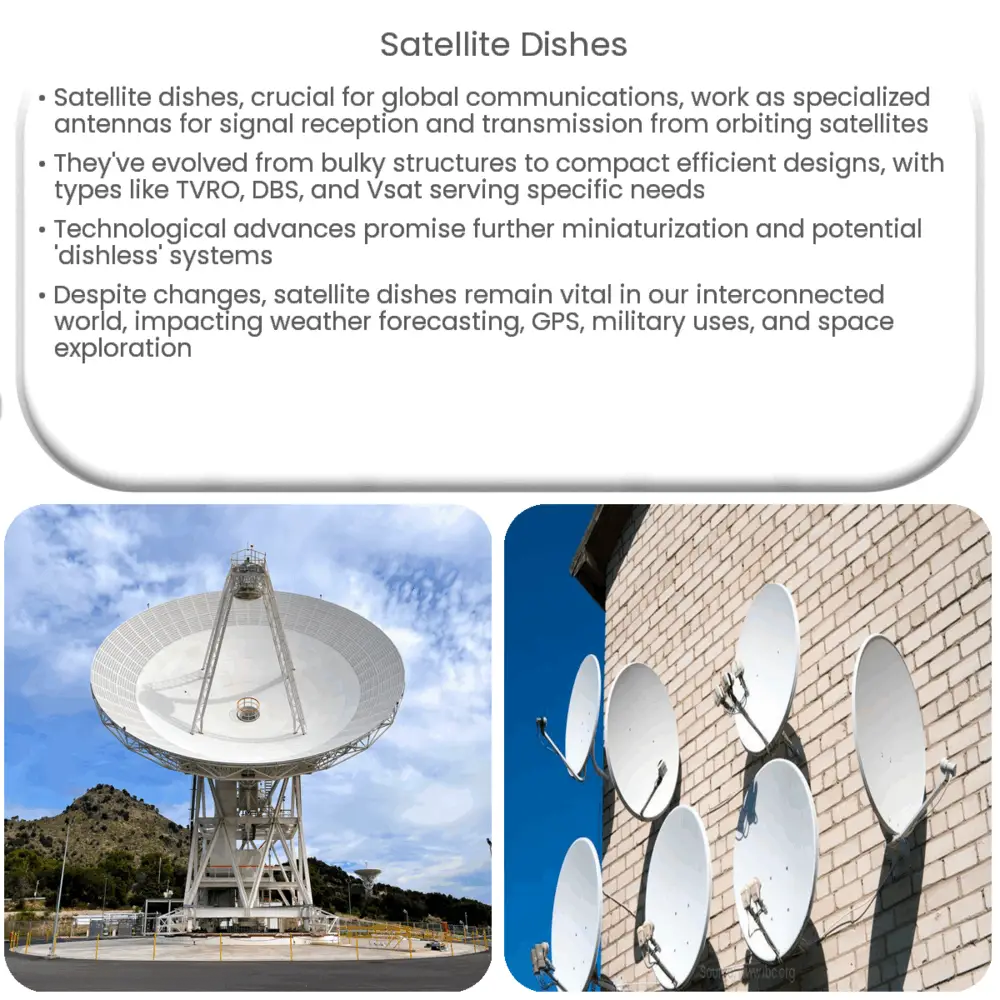Explore the world of satellite dishes, their function, types, evolution, and future prospects in our technologically advancing world.

A Deep Dive into Satellite Dishes
Satellite dishes have become an ubiquitous part of our contemporary landscape, punctuating both urban and rural skylines across the globe. These fascinating pieces of technology serve as integral conduits between our planet and the sprawling cosmos above us, facilitating a plethora of crucial communication services. In this article, we’ll delve into the function and significance of these devices, as well as their evolution over time.
The Function of Satellite Dishes
At their most fundamental level, satellite dishes function as specialized antennas designed for the reception and transmission of signals to and from satellites orbiting Earth. The primary component of a satellite dish is the parabolic reflector, a concave, bowl-shaped surface that effectively focuses signals onto a specific point, known as the feed horn. This allows the dish to ‘catch’ signals transmitted from satellites and convert them into electrical signals that can be processed by a television or computer.
- The Reception Process: Signals from satellites are essentially radio waves traveling at the speed of light. These waves, once intercepted by the dish, are reflected onto the dish’s feed horn. The feed horn then transmits these signals to the receiver (such as a television), which decodes the signal into a form that can be understood and displayed.
- The Transmission Process: While many satellite dishes are used solely for reception, others also transmit data. These dishes convert the data from a source (like a computer) into a high-frequency signal. This signal is sent to the feed horn, reflected off the dish, and beamed into space toward the intended satellite.
Types of Satellite Dishes
Over the years, the design of satellite dishes has evolved, leading to different types designed to serve specific needs. Some of the most commonly encountered types include:
- TVRO (Television Receive Only): As the name suggests, these are the traditional dishes that receive television broadcasts from satellites. They are typically large and require manual adjustment to align with different satellites.
- DBS (Direct Broadcast Satellite): These are smaller, more compact dishes that are used primarily for receiving direct-to-home TV services, such as those provided by satellite TV companies.
- Vsat (Very Small Aperture Terminal): These are small, highly efficient dishes used for a variety of applications including broadband internet, voice over IP, and data communications.
The Evolution of Satellite Dishes
Since the advent of satellite communication in the mid-20th century, satellite dishes have undergone significant evolution. The first dishes were large and bulky structures, typically measuring several meters in diameter. These cumbersome devices required a lot of space and were mostly used by government and commercial entities.
With technological advancements, dishes have become increasingly smaller and more efficient. The shift towards miniaturization began in earnest with the introduction of DBS services in the 1990s. These services allowed for the reception of satellite TV broadcasts with small, home-mounted dishes, revolutionizing the consumer market. Today, dishes as small as 45 centimeters in diameter are capable of providing high-quality digital signals for television and internet services.
Future of Satellite Dishes
As technology continues to advance, the role and design of satellite dishes are set to change. The push towards higher frequencies may necessitate smaller, more accurate dishes. Furthermore, the advent of technologies such as phased array antennas, which can electronically steer signals without the need for physical dish movement, could lead to the development of ‘dishless’ satellite systems.
Satellite Dishes in the Modern World
While many people see satellite dishes as merely a means to watch television or access the internet, their role is much more pervasive. They play a crucial role in weather forecasting, GPS systems, military applications, and even deep space exploration. As we become more reliant on global communications and data, the importance of these devices in our day-to-day lives is likely to grow.
Conclusion
In conclusion, satellite dishes serve as a testament to our technological progress and our ceaseless ambition to explore and understand the cosmos. They represent a critical part of our global infrastructure, bridging distances and bringing information to our fingertips. Despite the rapid changes and advancements in technology, it is clear that for the foreseeable future, satellite dishes will continue to play an indispensable role in our journey towards an interconnected world.

